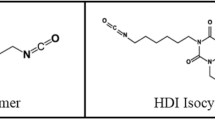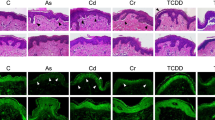Abstract
Human epidermal keratinocytes in culture were studied to evaluate their usefulness in demonstrating toxic events following exposure to sulfur mustard. Exposure of keratinocytes to sulfur mustard over a concentration range of 1–1000 μM HD, reduced NAD+ levels from 96% to 32% of control levels. When keratinocytes were exposed to a concentration of 300 μM HD, NAD+ levels began to fall at 1 hour and reached a plateau of 47% of control levels at 4 hours. Niacinamide, an inhibitor of the enzyme poly(ADP-ribose) polymerase, partially protected mustard-exposed cells against NAD+ depletion. It also protected cellular viability as assessed by vital staining 24 hours after exposure. This protection was not seen in long-term (72 hr) cultures. These studies suggest that human epidermal keratinocytes in culture can serve as a usefulin vitro model for research into the biochemical mechanisms of sulfur mustard-induced cutaneous injury.
Similar content being viewed by others
Abbreviations
- HD:
-
sulfur mustard, 2,2′-dichlorodiethyl sulfide
- NAD+:
-
nicotinamide adenine dinucleotide
- ADP:
-
adenosine diphosphate
- HEK:
-
human epidermal keratinocytes
- PI:
-
propidium iodide
References
BOYCE, S.T. and HAM, R.G. (1983). Calcium-regulated differentiation of normal human epidermal keratinocytes in chemically defined clonal culture and serum-free serial culture. J. Invest Dermatol.81:33s-40s.
GROSS, C.L., MEIER, H.L., PAPIRMEISTER, B., BRINKLEY, F.B., and JOHNSON, J.B. (1985). Sulfur mustard lowers nicotinamide adenine dinucleotide concentrations in human skin grafted to athymic nude mice. Toxicol. Appl. Pharmacol.81:85–90.
JACOBSON, E.L. and JACOBSON, M.K. (1976). Pyridine nucleotide levels as a function of growth in normal and transformed 3T3 cells. Arch. Biochem. Biophys.175:627–634.
MC ADAMS, A.J. (1956). A study of mustard vesication. J. Invest. Dermatol.26:317–326.
MEIER, H.L., GROSS, C.L. and PAPIRMEISTER, B. (1987). 2,2′-Dichlorodiethyl sulfide (sulfur mustard) decreases NAD+ levels in human leukocytes. Toxicol. Lett.39:109–122.
PAPIRMEISTER, B., GROSS, C.L., PETRALI, J.P. and HIXSON, C.J. (1984). Pathology produced by sulfur mustard in human skin grafts on athymic nude mice. I. Gross and light microscopic changes. J. Toxicol.-Cut & Ocular Toxicol.3:371–391.
PAPIRMEISTER, B., GROSS, C.L., MEIER, H.L., PETRALI, J.P. and JOHNSON, J.B. (1985). Molecular basis for mustard-induced vesication. Fundament. appl. Toxicol.5:S134-S149.
RENSHAW, B. (1947). Observations on the role of water in the susceptibility of human skin to injury by vesicant vapors. J. Invest. Dermatol.9:75–85.
SCHWARZ, F. (1937). Experimental studies on mustard action. Protar.3:34–37.
Author information
Authors and Affiliations
Rights and permissions
About this article
Cite this article
Smith, W.J., Gross, C.L., Chan, P. et al. The use of human epidermal keratinocytes in culture as a model for studying the biochemical mechanisms of sulfur mustard toxicity. Cell Biol Toxicol 6, 285–291 (1990). https://doi.org/10.1007/BF02443803
Accepted:
Issue Date:
DOI: https://doi.org/10.1007/BF02443803




